I remember the first time I tasted elderflower tea—it was at a farmer’s market on a crisp spring morning. The vendor had this tiny stand draped in lace, with steam rising from a delicate porcelain teapot. She handed me a small cup, and the moment that floral aroma hit me, I was hooked. It reminded me of summers spent in my grandmother’s garden, where elderflower bushes grew wild along the fence. We never turned those blossoms into tea back then, but if she were here today, I know she’d approve of this calming ritual.
Elderflower tea isn’t just tasty—it’s a simple, natural way to slow down and support your body with every sip. It has that gentle floral warmth that makes you feel wrapped in a blanket, especially when paired with quiet mornings or evening reflection. In this guide, I’ll show you exactly how to make the perfect elderflower tea recipe at home, with ingredients that are easy to source and a process so soothing, you might just fall in love with it like I did.
Whether you’re new to herbal teas or you already brew your own blends, this recipe is one you’ll want to bookmark. It’s light, fragrant, and surprisingly versatile. Let’s start with what makes elderflower so special.
Table of Contents
Why Elderflower Tea Is My Go-To Herbal Brew
What is Elderflower and Why You’ll Love It
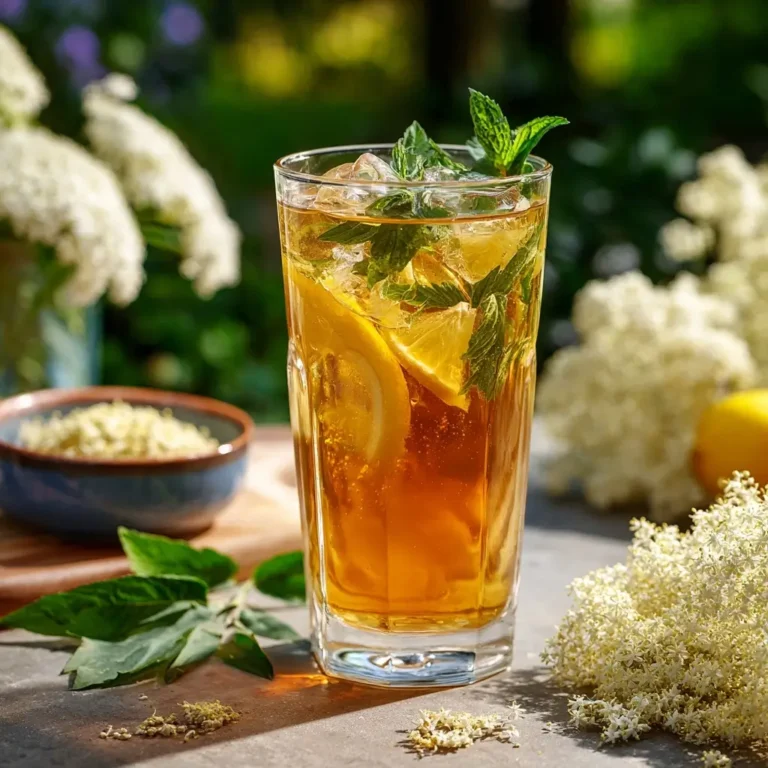
Elderflowers come from the elderberry plant (Sambucus nigra), but unlike the berries that require cooking, the blossoms can be steeped fresh or dried to make tea. The flavor? Think floral, slightly honeyed, with just a whisper of earthiness. It’s gentle on the stomach and kind to your senses. I love making elderflower tea in the morning before diving into my day, or at night when I need something caffeine-free that still feels like a treat.
What makes it so wonderful is its natural antioxidant content. While it’s not a medical cure-all, elderflower tea is traditionally enjoyed for helping with seasonal colds, reducing inflammation, and supporting immune function. Just like my favorite lemon balm tea for weight loss, it’s part of my self-care arsenal when I feel run-down or overwhelmed.
And don’t even get me started on the aroma—it’s like walking through a flower field in late May. Pure herbal bliss.
The Simplicity of Ingredients Matters
What I love most about this elderflower tea recipe is how pure it is. Just dried elderflowers, hot water, and a touch of natural sweetener if you’re into that. No caffeine. No artificial additives. And definitely no ingredients that mess with your gut. I often sip it alongside something energizing like this blue tonic recipe for weight loss to balance calm and energy.
You can find dried elderflowers online or at natural health stores, but if you’re lucky enough to spot them fresh in the wild (make sure they’re Sambucus nigra), harvest them safely and dry them at home. They keep beautifully in a glass jar for months.
Here’s a quick reference table for what you need and why each ingredient matters:
| Ingredient | Purpose |
|---|---|
| Dried elderflowers | Main ingredient, delivers floral flavor and herbal properties |
| Hot water | Extracts aroma and natural compounds from blossoms |
| Raw honey or lemon (optional) | Adds natural sweetness or a zesty twist |
How to Make the Perfect Cup of Elderflower Tea
Step-by-Step Brewing Method (The Easy Way I Do It)
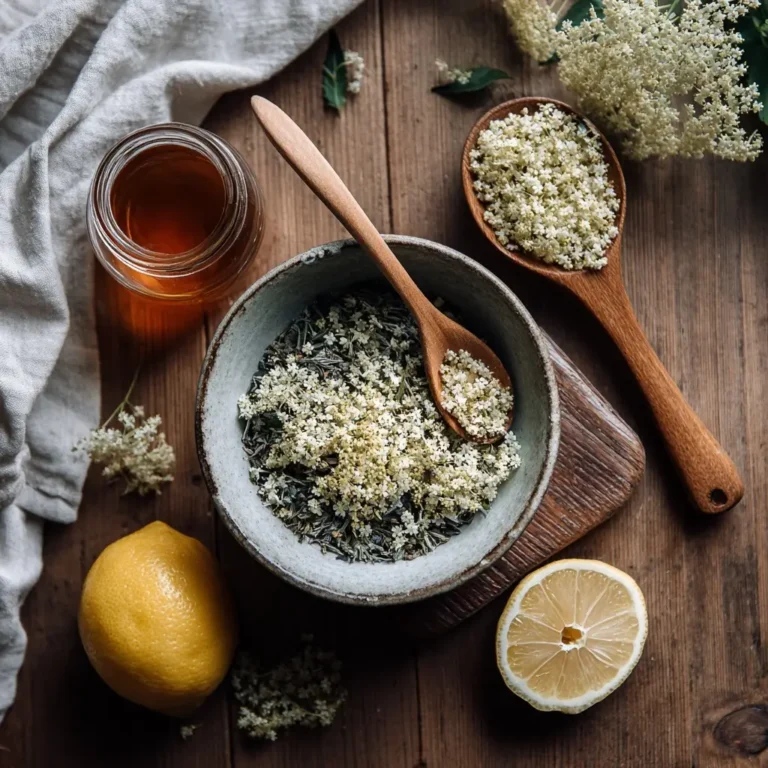
Making this elderflower tea recipe is truly relaxing—it’s part of why I love it so much. There’s something almost meditative about watching dried blossoms swirl in hot water, releasing their fragrance like a floral steam bath.
Here’s how I make mine:
You’ll need:
- 1 tablespoon dried elderflowers (or 2–3 fresh heads if available)
- 1 cup just-boiled water
- Optional: slice of lemon, raw honey, or a few mint leaves
Directions:
- Place the elderflowers in a tea infuser, teapot, or directly in your cup.
- Pour freshly boiled water over them.
- Cover and let steep for 7–10 minutes—longer for stronger flavor.
- Strain if needed, sweeten to taste, and enjoy.
That’s it. No overthinking, no fancy gear. I usually sip mine from my favorite stoneware mug, often while reading or journaling. It’s one of those small daily rituals that keeps me grounded.
This brewing method is just as fuss-free as my go-to Costa Rican tea method—they both rely on natural ingredients and slow, intentional preparation. You don’t need a kitchen full of tools—just time, patience, and the right blossoms.
Flavor Twists You’ll Love
Once you’ve got the basic elderflower tea recipe down, you can have a little fun with it. The floral base pairs beautifully with citrus, spices, and even other herbs.
Here are my top combos:
- With lemon balm: Add a pinch of lemon balm while steeping for extra calming benefits.
- With mint: Especially good when served cold—super refreshing!
- With ginger slices: Add gentle heat that helps digestion and soothes nausea.
- With hibiscus: For a tart, bright pink floral blend that tastes amazing over ice.
Want something cozy and caffeine-free in the evening? Add a cinnamon stick while steeping. It reminds me a bit of the scent from my natural mounjaro tea blend, only gentler.
Don’t be afraid to experiment with your elderflower tea recipe. Just make sure the other ingredients are equally gentle and natural—this tea shines in its simplicity.
Elderflower Tea for Detox & Daily Wellness
Why I Reach for This Tea When I’m Feeling Off
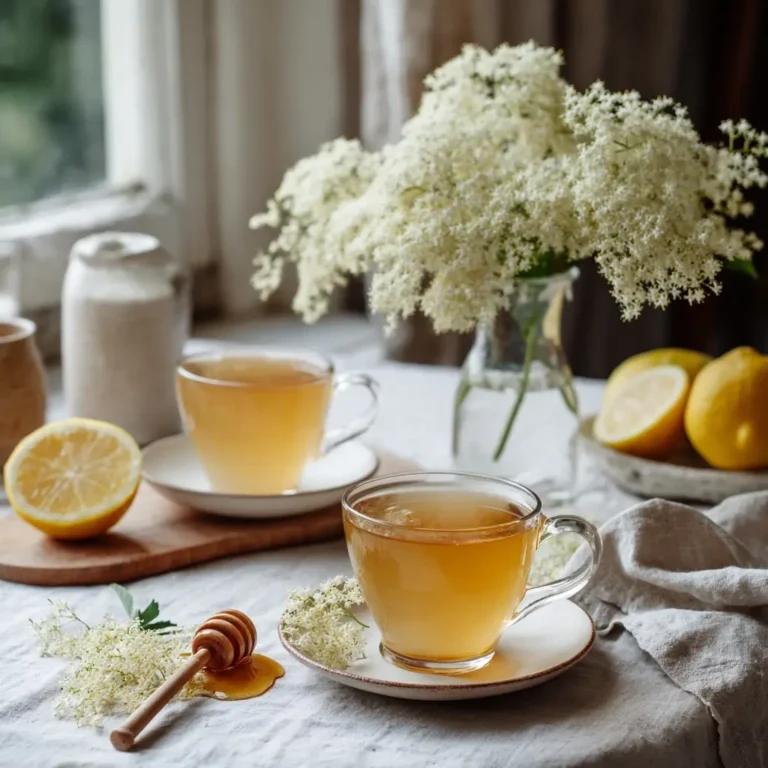
There are days when my body feels “off.” Not sick—just sluggish, puffy, or foggy. That’s when I reach for elderflower tea. It’s gentle but works behind the scenes to support my system. I’ve noticed a difference in how I feel after drinking it for a few days in a row—my digestion feels lighter, and my sinuses clear up more quickly when I have a seasonal cold.
Traditionally, elderflower tea is known for supporting respiratory health, soothing inflammation, and promoting gentle detoxification. I like to think of it as my body’s botanical backup team.
When I pair elderflower tea with practices like dry brushing and clean meals, I feel lighter, mentally and physically. It’s a slower kind of self-care, unlike quick-fix solutions. One thing I often pair it with is my favorite baking soda detox drink when I want a mild internal reset—without harsh ingredients or gimmicks.
What’s remarkable is how effective this floral brew is at making you feel nurtured. It’s not just a drink—it’s a moment of reconnection.
A Natural Fit in Any Holistic Routine
Whether you’re into mindful eating, detoxing, or just want fewer processed things in your life, elderflower tea fits right in. It doesn’t fight your body—it flows with it. There’s no caffeine crash, no hidden sugars. Just blossoms and water, doing their thing.
In spring and summer, I sip it cold with lemon or mint. In fall and winter, I go warm and honeyed. That adaptability is one reason it sits next to my more functional teas, like the green tea drink I brew for antioxidants and focus.
This tea works for me year-round, whether I’m focused on hormone support, inflammation, or just replacing a second cup of coffee. It keeps me hydrated, grounded, and intentional.
It’s also safe to share with older kids or family members trying to cut back on caffeine. I’ve even served a chilled version at brunch, garnished with fresh herbs. Every time, people are surprised by the flavor. It’s not just another herbal tea—it’s got personality.
How to Serve, Store, and Enjoy Elderflower Tea Year-Round
Beautiful Ways to Serve It (Hot or Iced!)
What’s great about this elderflower tea recipe is how well it adapts to the seasons. In winter, I serve it hot with a drizzle of honey and a slice of lemon. In summer, it becomes an iced floral tonic I love pouring over crushed ice with mint sprigs. It looks stunning in a glass pitcher—pale gold, like sunshine you can sip.
If you’re feeling fancy, float an edible flower or thin cucumber ribbon in your iced tea. It’s also a lovely non-caffeinated option for baby showers or outdoor brunches—just like the pineapple ginger detox drink I serve when I want something bright and hydrating.
For guests who aren’t into herbal teas, I’ve had success blending elderflower with lemon and hibiscus or even pairing it with a natural Ozempic-style recipe that adds metabolic support with a slightly tangy edge.
How to Store Dried Elderflowers the Right Way
To get the most from your elderflower stash, store it in an airtight glass jar in a cool, dark place. I label mine with the date so I remember when I dried or bought them. While they’re best within 6–9 months, I’ve brewed lovely tea from blossoms that were nearly a year old. Just make sure they still have that delicate floral aroma and haven’t lost color.
Never use flowers from roadside bushes or ones that have been sprayed. And always identify properly—elderflower is safe when harvested correctly, but other varieties of elder (especially red elderberry) are not edible raw. When in doubt, buy from a trusted herbal supplier.
Gentle Wellness in Every Sip
This elderflower tea recipe has become one of my favorite herbal rituals—simple, healing, and elegant. It doesn’t need hype to prove its value. The scent alone calms me, and the warm mug in my hands reminds me to slow down.
Whether you’re exploring herbalism or just need a beautiful daily tea, elderflower is worth discovering. I encourage you to make a batch, pair it with a moment of quiet, and feel the difference.
And if you loved this, you might also enjoy browsing my Pinterest page for more floral tea ideas and healing drinks to save for later.
FAQs About Elderflower Tea Recipe
Can I use fresh elderflowers instead of dried?
Yes! Use 2–3 fresh flower heads per cup. Rinse gently and use immediately after picking.
Is elderflower tea safe during pregnancy?
It’s best to check with your doctor, but moderate use of elderflower tea (not the berries) is generally considered safe in small amounts.
What does elderflower tea taste like?
It’s floral, soft, and slightly sweet—similar to chamomile but more fragrant.
Can I drink elderflower tea every day?
Yes, many people enjoy it daily. Just be mindful if you have pollen allergies—start with a small amount and monitor how your body responds.
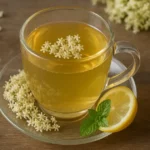
Elderflower Tea Recipe for a Soothing Wellness Ritual
- Total Time: 12
- Yield: 1 cup 1x
- Diet: Vegan
Description
A floral, naturally caffeine-free herbal tea recipe made from dried or fresh elderflowers. Great for wellness, digestion, and relaxation.
Ingredients
1 tbsp dried elderflowers (or 2–3 fresh heads)
1 cup boiling water
Raw honey or lemon (optional)
Instructions
Step 1: Place elderflowers in a teapot or infuser.
Step 2: Pour over hot water and cover.
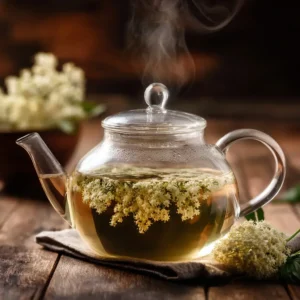
Step 3: Steep for 7–10 minutes.
Step 4: Strain and sweeten if desired.
Step 5: Serve hot or iced.
Notes
Use only edible elderflowers (Sambucus nigra).
Store dried flowers in a glass jar away from sunlight.
Great with mint, lemon balm, or ginger.
- Prep Time: 2
- Cook Time: 10
- Category: Herbal Tea
- Method: Steeping
- Cuisine: Wellness
Nutrition
- Serving Size: 1 cup
- Calories: 5
- Sugar: 0
- Sodium: 0
- Fat: 0
- Saturated Fat: 0
- Unsaturated Fat: 0
- Trans Fat: 0
- Carbohydrates: 1
- Fiber: 0
- Protein: 0
- Cholesterol: 0

